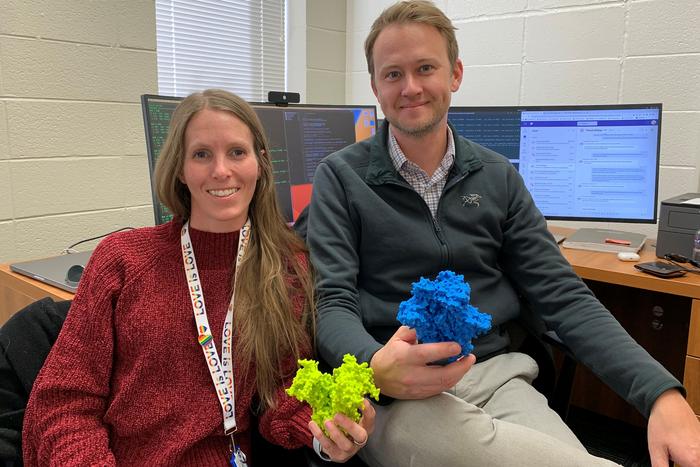DURHAM, N.C. – As the HIV virus glides up outside a human cell to dock and possibly inject its deadly cargo of genetic code, there’s a spectacularly brief moment in which a tiny piece of its surface snaps open to begin the process of infection.

Credit: Duke University
DURHAM, N.C. – As the HIV virus glides up outside a human cell to dock and possibly inject its deadly cargo of genetic code, there’s a spectacularly brief moment in which a tiny piece of its surface snaps open to begin the process of infection.
Seeing that structure snap open and shut in mere millionths of a second is giving Duke Human Vaccine Institute (DHVI) investigators a new handle on the surface of the virus that could lead to broadly neutralizing antibodies for an AIDS vaccine. Their findings appear Feb. 2 in Science Advances.
Being able to attach an antibody specifically to this little structure that would prevent it from popping open would be key. Their findings appear Feb. 2 in Science Advances.
The moving part is a structure called envelope glycoprotein, and AIDS researchers have been trying to figure it out for years because it is a key part of the virus’ ability to dock on a T-cell receptor known as CD4. Many parts of the envelope are constantly moving to evade the immune system, but vaccine immunogens are designed to stay relatively stable.
“Everything that everybody’s done to try to stabilize this (structure) won’t work, because of what we learned,” said lead author Rory Henderson, a structural biologist who is an associate professor of medicine in DHVI. “It’s not that they did something wrong; it’s just that we didn’t know it moves this way.”
Postdoctoral researcher and study co-author Ashley Bennett offers a play-by-play: As the virus feels for its best attachment point on a human T-cell, the host cell’s CD4 receptor is the first thing it latches onto. That connection is what then triggers the envelope structure to pop open, which in turn, exposes a co-receptor binding site “and that’s the event that actually matters.”
Once both molecules of the virus are bound to the cell membrane, the process of injecting viral RNA can begin. “If it gets inside the cell, your infection is now permanent,” Henderson said.
“If you get infected, you’ve already lost the game because it’s a retrovirus,” Bennett agrees.
The moving structure they found protects the sensitive co-receptor binding site on the virus. “It’s also a latch to keep it from springing until it’s ready to spring,” Henderson said. Keeping it latched with a specific antibody would stop the process of infection.
To see the viral parts in various states of open, closed and in-between, Bennett and Henderson used an electron accelerator at the Argonne National Laboratory outside Chicago that produces X-rays in wavelengths that can resolve something as small as a single atom. But this expensive, shared equipment is in high demand. The AIDS researchers were awarded three 120-hour blocks of time with the synchrotron to try to get as much data as they could in marathon sessions. “Basically, you just go until you can’t anymore,” Bennett said.
Earlier research elsewhere had argued that antibodies were being designed for the wrong shapes on the virus and this work shows that was probably correct.
“The question has been ‘why, when we immunize, are we getting antibodies to places that are supposed to be blocked?’” Henderson said. Part of the answer should lie in this particular structure and its shape-shifting.
“It’s the interplay between the antibody binding and what this shape is that’s really critical about the work that we did,” Henderson said. “And that led us to design an immunogen the day we got back from the first experiment. We think we know how this works.”
This research was supported by the National Institutes of Health (UM1AI14437, R01AI145687, U54AI170752, P30 GM124169, S10OD018483), the Department of Energy (DE-AC02-06CH11357) and the DOE Office of Biological and Environmental Research.
CITATION: “Microsecond Dynamics Control the HIV-1 Envelope Conformation,” Ashley L. Bennett, R.J. Edwards, Irina Kosheleva, Carrie Saunders, Yishak Bililign, Ashliegh Williams, Pimthada Bubphamala, Katayoun Manosouri, Kara Anasti, Kevin O. Saunders, S. Munir Alam, Barton F. Haynes, Priyamvada Acharya, Rory Henderson. Science Advances, Feb. 2, 2024. DOI: 10.1126/sciadv.adj0396
Journal
Science Advances
DOI
10.1126/sciadv.adj0396
Method of Research
Observational study
Subject of Research
Not applicable
Article Title
Microsecond Dynamics Control the HIV-1 Envelope Conformation
Article Publication Date
2-Feb-2024




